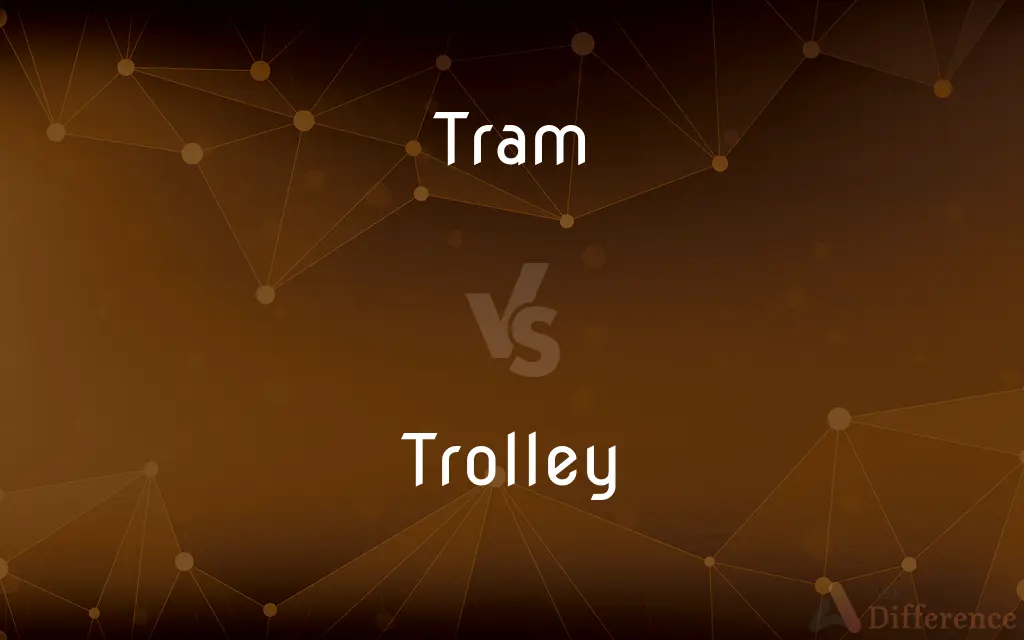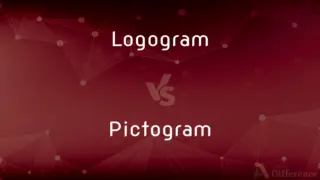Tram vs. Trolley — What's the Difference?
Edited by Tayyaba Rehman — By Fiza Rafique — Updated on March 28, 2024
Trams run on tracks and are primarily used for urban public transport; trolleys can be buses powered by overhead electric wires or the same as trams in some regions.

Difference Between Tram and Trolley
Table of Contents
ADVERTISEMENT
Key Differences
Trams are rail vehicles that run on tramway tracks along public urban streets and sometimes on separate rights of way. They are used for public transport in many cities around the world. Trams are known for their ability to transport a large number of passengers efficiently and are often powered by electricity through overhead cables. On the other hand, trolleys, in the United States, can refer to both electric streetcars similar to trams and to rubber-tired trolleybuses that are powered by overhead electric wires but run on roads instead of rails.
While trams typically have their own designated tracks that may be shared with other vehicles only in certain sections, trolleys, especially trolleybuses, share road space with other vehicles, which can lead to differences in their operational efficiency and speed. Trams, due to running on rails, can offer a smoother ride compared to the road-running trolleybuses. However, trolleybuses have the advantage of being able to navigate around obstacles more easily than trams.
The term "trolley" originally referred to the trolley pole used to transfer electricity from overhead wires to the vehicle. This is a common feature in both trams and trolleybuses. Whereas trams are an integral part of the urban transit system in many cities worldwide, known for their capacity and efficiency, trolleybuses are less common and are valued for their flexibility and lower upfront infrastructure costs compared to trams.
In some regions, the terms tram and trolley are used interchangeably, which can lead to confusion. For example, in parts of the United States, what is known as a tram in Europe might be called a trolley or streetcar. This interchangeability of terms highlights the importance of context when discussing these modes of transport.
Despite their differences, both trams and trolleys contribute significantly to reducing urban congestion and pollution by providing an electric alternative to car travel. They are vital components of sustainable urban transport systems, offering reliable and efficient services to commuters.
ADVERTISEMENT
Comparison Chart
Definition
A rail vehicle for urban transport
Can refer to electric streetcars or trolleybuses
Operation Terrain
On tracks, sometimes on public roads
On roads or tracks
Power Source
Usually electric, overhead cables
Electric, overhead cables or internal combustion
Common Usage
Urban public transport
Urban and some suburban areas
Flexibility
Fixed routes due to tracks
More flexible, especially trolleybuses
Compare with Definitions
Tram
A tram is a rail vehicle used primarily in urban areas for public transport.
The city's tram system efficiently connects different neighborhoods.
Trolley
Trolleybuses, unlike trams, can maneuver around obstacles on the road.
The trolleybus driver expertly navigated through the busy traffic.
Tram
Designed to carry a large number of passengers, trams are ideal for busy city routes.
During rush hour, the tram becomes a preferred choice for its high capacity.
Trolley
Trolleys serve both urban and suburban areas, providing an essential link.
Residents rely on the trolley to connect them to the city center.
Tram
Trams run on tracks and are typically powered by electricity through overhead cables.
She admired the tram gliding smoothly on its tracks, powered by the overhead lines.
Trolley
Trolleybuses often have lower initial infrastructure costs compared to trams.
The city opted for trolleybuses to avoid the high cost of laying tram tracks.
Tram
Trams often run on dedicated tracks, reducing interference from other traffic.
The dedicated tram tracks made the commute faster and more reliable.
Trolley
The term "trolley" comes from the trolley pole used to connect the vehicle to the overhead wires.
The trolley's pole disconnected, and the driver had to reattach it.
Tram
Many cities maintain historic trams for tourism alongside modern systems for daily commute.
Tourists enjoy rides on the historic tram, offering a glimpse into the city's past.
Trolley
A trolley can refer to an electric streetcar similar to a tram or a rubber-tired trolleybus.
The trolley buzzed down the street, its poles connected to the overhead wires.
Tram
A tram (in North America streetcar or trolley) is a train that runs on tramway track on public urban streets; some include segments of segregated right-of-way. The lines or networks operated by tramcars as public transport are called tramways or simply tram/streetcar.
Trolley
A large metal basket or frame on wheels, used for transporting heavy or large items, such as supermarket purchases or luggage at an airport or railway station.
Tram
A streetcar.
Trolley
A wheel attached to a pole, used for collecting current from an overhead electric wire to drive a tram.
Tram
A streetcar line.
Trolley
Short for trolleybus or trolley car
Tram
A cable car, especially one that rolls along an overhead cable along which it is drawn by a second, moving cable.
Trolley
A streetcar.
Tram
A four-wheeled, open, box-shaped wagon or car run on tracks in a mine.
Trolley
A device that collects electric current from an underground conductor, an overhead wire, or a third rail and transmits it to the motor of an electric vehicle.
Tram
An instrument for gauging and adjusting machine parts; a trammel.
Trolley
A small truck or car operating on a track and used in a mine, quarry, or factory for conveying materials.
Tram
Accurate mechanical adjustment
The device is in tram.
Trolley
A wheeled carriage, cage, or basket that is suspended from and travels on an overhead track.
Tram
A shiny silk thread with very little twist, primarily used as a weft yarn.
Trolley
Chiefly British A light cart designed to be moved by hand.
Tram
To move or convey in a tram.
Trolley
To convey (passengers) or travel by trolley.
Tram
To adjust or align (mechanical parts) with a trammel.
Trolley
A trolley pole; a single-pole device for collecting electrical current from an overhead electrical line, normally for a tram/streetcar or a trolleybus.
Tram
A passenger vehicle for public use that runs on tracks in the road (called a streetcar or trolley in North America).
Trolley
(US) A streetcar or light train.
Tram
A similar vehicle for carrying materials.
Trolley
A light rail, tramway, trolleybus or streetcar system.
Tram
A people mover.
Trolley
A truck from which the load is suspended in some kinds of cranes.
Tram
(US) An aerial cable car.
Trolley
A truck which travels along the fixed conductors in an electric railway, and forms a means of connection between them and a railway car.
Tram
(US) A train with wheels that runs on a road; a trackless train.
Trolley
A cart or shopping cart; a shopping trolley.
Tram
A car on a horse railway or tramway (horse trams preceded electric trams).
Trolley
(British) A hand truck.
Tram
(obsolete) The shaft of a cart.
Trolley
(British) A soapbox car.
Tram
(obsolete) One of the rails of a tramway.
Trolley
(British) A gurney, a stretcher with wheeled legs.
Tram
(weaving) A silk thread formed of two or more threads twisted together, used especially for the weft, or cross threads, of the best quality of velvets and silk goods.
Trolley
(Philippines) A handcar.
Tram
(intransitive) To operate, or conduct the business of, a tramway.
Trolley
To bring to by trolley.
Tram
(intransitive) To travel by tram.
Trolley
To use a trolley vehicle to go from one place to another.
Tram
(transitive) To transport (material) by tram.
Trolley
To travel by trolley (streetcar, trolleybus or light train).
Tram
To align a component in mechanical engineering or metalworking, particularly the head of a drill press.
Trolley
A form of truck which can be tilted, for carrying railroad materials, or the like.
Tram
(weaving) To weave in this manner.
Trolley
A wheeled vehicle that runs on rails and is propelled by electricity;
`tram' and `tramcar' are British terms
Tram
A four-wheeled truck running on rails, and used in a mine, as for carrying coal or ore.
Tram
The shaft of a cart.
Tram
One of the rails of a tramway.
Tram
A car on a horse railroad.
Tram
A silk thread formed of two or more threads twisted together, used especially for the weft, or cross threads, of the best quality of velvets and silk goods.
Tram
To convey or transport on a tramway or on a tram car.
Tram
To operate, or conduct the business of, a tramway; to travel by tramway.
Tram
A conveyance that transports passengers or freight in carriers suspended from cables and supported by a series of towers
Tram
A four-wheeled wagon that runs on tracks in a mine;
A tramcar carries coal out of a coal mine
Tram
A wheeled vehicle that runs on rails and is propelled by electricity;
`tram' and `tramcar' are British terms
Common Curiosities
What is the main difference between a tram and a trolley?
A tram is a rail vehicle primarily for urban transport on tracks, while a trolley can refer to an electric streetcar or a trolleybus.
What makes trams preferred in urban transport?
Their high capacity and efficiency in transporting large numbers of passengers make them preferred.
Can trams and trolleys be powered by the same source?
Yes, both can be powered by electricity through overhead cables.
Are trolleybuses common in cities?
Trolleybuses are less common than trams but are used in some cities for their flexibility and lower costs.
Do both trams and trolleys help reduce urban congestion?
Yes, they provide efficient public transport options, reducing the need for cars.
Do trams always run on separate tracks?
Trams usually run on tracks, which can be on public roads or separate rights of way.
Can trolleybuses run without overhead wires?
Trolleybuses typically require overhead wires, but some have auxiliary engines for short distances.
How do trolleybuses navigate through traffic?
Trolleybuses can move around obstacles on the road, unlike trams which follow fixed tracks.
Are trams or trolleys more flexible in their routes?
Trolleys, especially trolleybuses, offer more flexibility as they can navigate around obstacles.
Where did the term "trolley" originate from?
It comes from the trolley pole used for electric power transmission to the vehicle.
Is it cheaper to install a tram system or a trolleybus system?
Trolleybus systems often have lower initial costs compared to tram systems.
Do trams have a smoother ride than trolleybuses?
Trams typically offer a smoother ride due to running on rails.
Can trams be used for tourism?
Yes, historic trams are often maintained for tourism alongside modern transport services.
What are the environmental benefits of trams and trolleys?
They reduce pollution and congestion by offering an electric alternative to personal vehicles.
Share Your Discovery

Previous Comparison
Logogram vs. Pictogram
Next Comparison
Knob vs. HandleAuthor Spotlight
Written by
Fiza RafiqueFiza Rafique is a skilled content writer at AskDifference.com, where she meticulously refines and enhances written pieces. Drawing from her vast editorial expertise, Fiza ensures clarity, accuracy, and precision in every article. Passionate about language, she continually seeks to elevate the quality of content for readers worldwide.
Edited by
Tayyaba RehmanTayyaba Rehman is a distinguished writer, currently serving as a primary contributor to askdifference.com. As a researcher in semantics and etymology, Tayyaba's passion for the complexity of languages and their distinctions has found a perfect home on the platform. Tayyaba delves into the intricacies of language, distinguishing between commonly confused words and phrases, thereby providing clarity for readers worldwide.















































